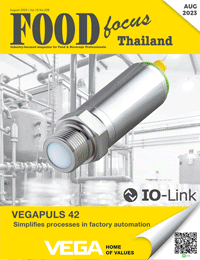การประยุกต์ใช้เอนไซม์ในหลากหลายผลิตภัณฑ์อาหาร Application of Enzymes in Various Food Products
1588 Views |

By: รศ. ดร. ธรรณพ เหล่ากุลดิลก
Assoc. Prof. Thunnop Laokuldilok, Ph.D.
Faculty of Agro-Industry
Chiang Mai University
Thunnop.l@cmu.ac.th
เอนไซม์เป็นโปรตีนที่มีลักษณะก้อนกลม มีหน้าที่เป็นตัวเร่งปฏิกิริยาเคมีต่างๆ ในกระบวนการเมแทบอลิซึม ในการนำเอนไซม์ไปใช้จะต้องคำนึงถึงธรรมชาติของเอนไซม์ชนิดนั้นๆ เช่น อุณหภูมิและค่า pH ที่เหมาะสม ความจำเพาะเจาะจงและโคแฟคเตอร์ เป็นต้น ซึ่งการใช้เอนไซม์ในอุตสาหกรรมอาหารมีข้อดีหลายประการ อาทิ เอนไซม์มีความจำเพาะต่อซับสเตรต (substrate) จึงทำให้มั่นใจว่าจะเกิดปฏิกิริยาได้ตรงเป้าหมาย ไม่ก่อให้เกิดอันตรายต่อผู้บริโภคเนื่องจากเอนไซม์เป็นโปรตีน และปฏิกิริยาของเอนไซม์เกิดขึ้นภายใต้สภาวะที่ไม่รุนแรงจึงไม่จำเป็นต้องใช้ความร้อนสูงหรือสารเคมีอันตราย
เอนไซม์สามารถแบ่งได้เป็น 6 ประเภท ตามชนิดของปฏิกิริยาที่สามารถเร่งได้ แต่มีเพียง 3 ประเภทที่นิยมใช้อุตสาหกรรมอาหาร ได้แก่ ออกซิโดรีดักเตส (oxidoreductase) ทรานส์เฟอเรส (transferase) และ ไฮโดรเลส (hydrolase) โดยเอนไซม์หลายชนิดมีความสามารถในการปรับปรุงหรือเปลี่ยนแปลงสมบัติเชิงหน้าที่ของอาหารได้ จึงถูกนำมาใช้เพื่อปรับปรุงคุณภาพผลิตภัณฑ์ ซึ่งการใช้เอนไซม์เพื่อปรับปรุงคุณภาพอาหารจะมีรายละเอียดที่แตกต่างกันในอาหารแต่ละชนิด อาทิ
การใช้เอนไซม์ในผลิตภัณฑ์เนื้อสัตว์
ในอุตสาหกรรมเนื้อสัตว์ เอนไซม์มีบทบาทสำคัญในการทำให้เนื้อนุ่ม ด้วยการเติมเอนไซม์ในกลุ่ม
โปรติเอส เช่น ปาเปนที่ได้จากยางมะละกอและบรอมีเลนที่ได้จากสับปะรด และในอุตสาหกรรมการผลิตซูริมิ เอนไซม์ทรานส์กลูตามิเนสจะมีบทบาทสำคัญต่อคุณภาพและสมบัติเชิงหน้าที่ของผลิตภัณฑ์อย่างมาก
การใช้เอนไซม์ในผลิตภัณฑ์ขนมอบ
ในอุตสาหกรรมขนมปัง การเติมเอนไซม์จากแหล่งอื่นในโด (dough) มีวัตถุประสงค์เพื่อปรับปรุงสมบัติการไหล ความสามารถในการกักเก็บก๊าซ และช่วยให้เนื้อสัมผัสด้านในของขนมปังนุ่ม ซึ่งปัจจุบันมีการใช้เอนไซม์แอลฟา-อะไมเลส จากจุลินทรีย์และมอลต์ โปรติเอส และลิพอกซีจีเนส ในอุตสาหกรรมขนมอบอย่างแพร่หลาย
การใช้เอนไซม์ในผลิตภัณฑ์จากนม
เอมไซม์เองก็มีบทบาทสำคัญในอุตสาหกรรมนมและผลิตภัณฑ์จากนมเช่นกัน โดยในอดีตมีการใช้เอนไซม์ที่สำคัญ ได้แก่ เรนเนต (หรืออาจเรียกว่า เรนนิน) นอกจากนี้ ยังมีการใช้โปรติเอสในการไฮโดรไลซ์โปรตีนเวย์ให้มีขนาดเล็กลง และยังมีเอนไซม์แลคเตสที่สามารถเปลี่ยนน้ำตาลแลคโตสให้เป็นน้ำตาลกาแลคโตสและกลูโคสได้ จึงมักมีการนำมาใช้ในการผลิตนมปราศจากแลคโตสที่กำลังได้รับความนิยมในปัจจุบัน
Enzymes are globular proteins that serve as biocatalysts, facilitating diverse chemical reactions within metabolism. When utilizing enzymes, it becomes essential to consider their specific properties, including optimal temperature and pH, specificity, cofactors, and more. The application of enzymes in the food industry offers numerous advantages. Firstly, enzymes exhibit substrate specificity, ensuring precise and targeted reactions. Moreover, their protein nature ensures they pose no harm to consumers. Additionally, enzymatic reactions occur under mild conditions, eliminating the requirement for high heat or hazardous chemicals.
Enzymes can be categorized based on the specific type of reaction they can catalyze, with a total of 6 types in existence. However, in the food industry context, only 3 of these enzyme types find common usage: oxidoreductases, transferases, and hydrolases. Many enzymes possess the remarkable capacity to enhance or modify the functional properties of food, making them invaluable for improving overall product quality. However, the application of enzymes to enhance food quality can vary significantly, for example:
Use of enzymes in meat products
In the meat industry, enzymes play a pivotal role in meat tenderization. Protease enzymes like papain, derived from papaya sap and bromelain, derived from pineapple are added to achieve this effect. Within the surimi production industry, transglutaminase assumes a crucial role in enhancing the quality and functional properties of products.
Use of enzymes in baked products
In the bread industry, incorporating enzymes from external sources into the dough enhances its rheological properties, gas retention capacity, and breadcrumb softness. Microbial α-amylase and malt, Proteases, and lipoxygenase find widespread usage in the baking industry.
Use of enzymes in dairy products
Enzymes play an important role in the milk and dairy industry. One significant enzyme used historically is rennet (also known as rennin). Additionally, proteases are utilized to hydrolyze whey protein into smaller fractions as well as the enzyme lactase, responsible for converting lactose into galactose and glucose, finds application in the production of lactose-free milk.






